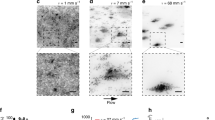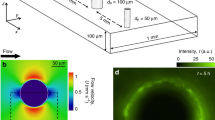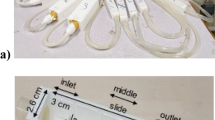Abstract
Phase and computer-enhanced microscopy were used to observe the surface microenvironment of continuous-flow slide cultures during microbial colonization and to document the diversity of bacterial colonization maneuvers among natural stream populations. Surface colonization involved 4 discrete types of cell movement, which were designated as packing, spreading, shedding, and rolling maneuvers. Each maneuver appeared to be associated with a specific species population within the community. The packing maneuver resulted in the formation of a monolayer of contiguous cells, while spreading maneuvers resulted in a monolayer of adjacent cells. During the shedding maneuver, cells attached perpendicular to the surface and the daughter cells were released. The rate of growth of new daughter cells gradually decreased as the attached mother cell aged. During the rolling maneuver, cells were loosely attached and continuously somersaulted across the surface as they grew and divided. Only those populations with a packing maneuver conformed fully to the assumptions of kinetics used previously to calculate growth and attachment rates from cell number and distribution. Consequently, these kinetics are not applicable to stream communities unless fluorescent antisera are used to study specific species populations within natural communities. Virtually all of the cells that attached to the surface were viable and underwent cell division. The abundance of unicells on surfaces incubated in situ was thus primarily the consequence of bacterial colonization behavior (shedding and spreading maneuvers) rather than the adhesion of dead or moribund cells.
Similar content being viewed by others
References
Bott TL, Brock TD (1970a) Growth rate ofSphaerotilus in a thermally polluted environment. App Microbiol 19:100–102
Bott TL, Brock TD (1970b) Growth and metabolism of periphytic bacteria: methodology. Limnol Oceanog 20:191–197
Brannan DK, Caldwell DE (1982) Evaluation of a proposed surface colonization equation usingThermothrix thiopara as a model organism. Microb Ecol 8:15–21
Brock TD (1971) Microbial growth rates in nature. Bacteriol Rev 35:39–58
Caldwell DE, Brannan DK, Morris ME, Betlach MR (1981) Quantitation of microbial growth on surfaces. Microb Ecol 7:1–12
Caldwell DE, Malone JA, Kieft TL (1983) Derivation of a growth rate equation describing surface colonization. Microb Ecol 9:1–6
Caldwell DE, Kieft TL, Brannan DK (1984) Colonization of sulfide-oxygen interfaces on hot spring tufa byThermothrix thiopara. Geomicrobiol J 3:181–200
Caldwell DE, Lawrence JR (in press) Study of attached cells in continuous-flow slide culture. Chapter 6. In: Wimpenney JWT (ed) A handbook of laboratory model systems for ecosystem research.
Caldwell DE, Lawrence JR (1986) Growth kinetics ofPseudomonas fluorescens in the hydrodynamic boundary layer of surface microenvironments. Microb Ecol 52:299–239
Caldwell DE (1984) Surface colonization parameters from cell density and distribution. In: Marshall KC (ed) Microbial adhesion and aggregation. Springer-Verlag, New York, pp 125–136
Carlile MJ (1980) Positioning mechanisms: the role of motility, taxis and tropism in the life of microorganisms. In: Ellwood DC, Hedger JN, Latham MJ, Lynch JM, Slater JH (eds) Contemporary microbial ecology. Academic Press, Toronto, pp 55–74
Helmsetter CE (1969) Sequence of bacterial reproduction. Annu Rev Microbiol 23:223–238
Henrici AT, Johnson DE (1935) Studies of freshwater bacteria II. Stalked bacteria, a new order of Schizomycetes. J Bacteriol 30:61–93
Hirsch P, Pankratz SH (1970) Study of bacterial populations in natural environments by use of submerged electron microscope grids. Z Allg Mikrobiol 10:589–605
Kieft TL, Caldwell DE (1983) A computer simulation of surface microcolony formation during microbial colonization. Microb Ecol 9:7–13
Kieft TL, Caldwell DE (1984) Chemostat and in situ colonization kinetics ofThermothrix thiopara on calcite and pyrite surfaces. Geomicrobiol J 3:217–229
Kjelleberg S, Humphrey BA, Marshall KC (1982) Effect of interfaces on small, starved marine bacteria. Appl Environ Microbiol 43:1166–1172
Lawrence JR, Delaquis PJ, Korber DR, Caldwell DE (1987) Behavior ofPseudomonas fluorescens within the hydrodynamic boundary layers of surface microenvironments. Microb Ecol 14:1–14.
Marshall KC, Cruickshank RH (1973) Cell surface hydrophobicity and the orientation of certain bacteria at interfaces. Arch Mikrobiol 92:29–40
Author information
Authors and Affiliations
Rights and permissions
About this article
Cite this article
Lawrence, J.R., Caldwell, D.E. Behavior of bacterial stream populations within the hydrodynamic boundary layers of surface microenvironments. Microb Ecol 14, 15–27 (1987). https://doi.org/10.1007/BF02011567
Issue Date:
DOI: https://doi.org/10.1007/BF02011567




